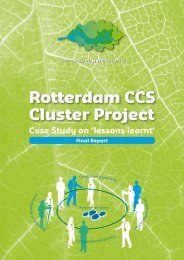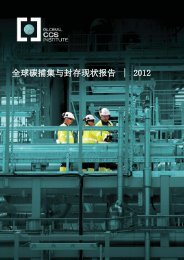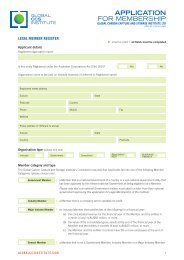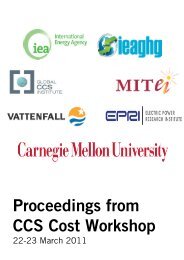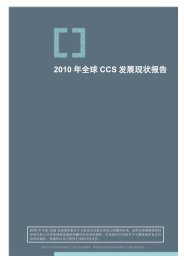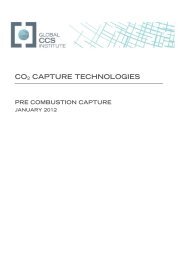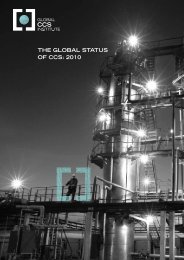Perceptions of CO2 Report - Global CCS Institute
Perceptions of CO2 Report - Global CCS Institute
Perceptions of CO2 Report - Global CCS Institute
- No tags were found...
You also want an ePaper? Increase the reach of your titles
YUMPU automatically turns print PDFs into web optimized ePapers that Google loves.
Recommendations derived from this work may be summarised as follows:• Efforts to promote dialog and understanding about <strong>CCS</strong> should incorporateinformation on CO 2 ’s properties and chemistry. Research found a limited knowledgebase among respondents. In the absence <strong>of</strong> such knowledge, members <strong>of</strong> the public maybe unclear on how to perceive CO 2 , and may subscribe to a variety <strong>of</strong> mistaken beliefs.• Balanced and complete information on CO 2 ’s properties should be made available.When communicating this information, it is important to include CO 2 ’s effects on humansand the environment (e.g., potential for soot-like effects and toxicity). Information regardingCO 2 ’s scientific and chemical properties was shown to have a weak but significant positiveeffect on <strong>CCS</strong> perceptions.• Topics deemed important by respondents should be addressed by communicators.The variation <strong>of</strong> reactions, anxieties, and beliefs amongst respondents highlighted theimportance <strong>of</strong> accounting for these in communication and education efforts regarding CO 2and <strong>CCS</strong>. Any effort to engage in dialogue with the public regarding <strong>CCS</strong> should be basedon an inventory and understanding <strong>of</strong> public levels <strong>of</strong> knowledge and information needs.This information can be collected through a baseline survey, as described in theCommunication/Engagement toolkit for <strong>CCS</strong> projects (Ashworth et al. 2011a).• Care should be taken in describing CO 2 natural phenomena. It is important to presentopen and transparent information, such as on incidents during which naturally-occurringCO 2 has harmed people, plants, and animals (i.e., the Lake Nyos 4 and Mount Mammoth 5events). Information on natural phenomena involving CO 2 had a weak but significantnegative effect on <strong>CCS</strong> perceptions, suggesting that people use these descriptions <strong>of</strong>natural phenomena to make inferences about <strong>CCS</strong>, CO 2 and its effects.• Care should be taken in describing the behaviour <strong>of</strong> CO 2 in the <strong>CCS</strong> process.Conveying correct and complete information on CO 2 ’s behaviour is important because thisunderstanding will be helpful to mitigate misunderstandings that can arise whenrespondents receive incomplete or indirect information about <strong>CCS</strong>.• Many members <strong>of</strong> the public still require basic information on climate change, <strong>CCS</strong>,and their relationship to CO 2 emissions. Awareness <strong>of</strong> these topics does not directlyimply knowledge, as for example, more participants indicated having heard <strong>of</strong> <strong>CCS</strong> than didactually understanding what it is.• Additional <strong>CCS</strong> education and outreach campaigns should be planned through lessformalmechanisms. Given that the correlation between trust in informal sources andpoorer understanding <strong>of</strong> <strong>CCS</strong>, sole reliance on the formal information and communicationsources (i.e., public sector organisations, local government, national newspapers, andscientists) may not reach the people with the poorest understanding <strong>of</strong> <strong>CCS</strong>, who insteadplace their trust in NGOs, friends, and the internet.4 In 1986, naturally-occurring CO 2 was released from Lake Nyos in Cameroon, killing animals and 1,700 people.5 At the Mount Mammoth volcano in the United States, a large volume <strong>of</strong> <strong>CO2</strong> seeping from underground has been killing trees.viii | Understanding how individuals perceive carbon dioxide




